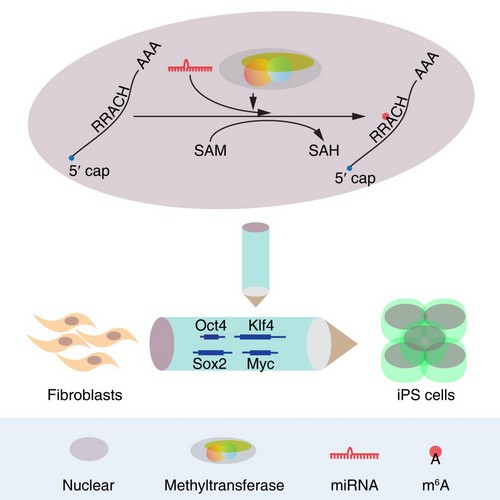Summary: Scientists have identified novel functions of microRNAs in regulating the formation of m6A RNA modification, and the positive role of m6A in promoting cell reprogramming. The findings reveal newmechanisms in regulating cell function and cell fate determination.
Researchers from Institute of Zoology, Beijing Institute of Genomics, and Institute of Genetics and Developmental Biology of Chinese Academy of Sciences (CAS) have discovered a new function of microRNAs in regulating the formation of N6-methyladenosine (m6A) RNA modification, together with the positive role of m6A in promoting cell reprogramming to pluripotency. Published online on Cell Stem Cell today, these findings open new directions in the functional studies of microRNAs, reveal the site selection mechanism of m6A formation, and identify m6A as a new regulator for cell reprogramming.
As a recently recognized epitranscriptomic marker, m6A is the most common and abundant modification on mRNA molecules in eukaryotes, which is linked to normal cell function regulation and the development of some diseases. Recently, m6A has become a new research frontier of gene expression regulation. A multi-component methyltransferase complex containing METTL3/METTL14/WTAP acts as the ‘writer’ for creating m6A, and the consensus sequence motif RRACH is the most enriched site for m6A formation. However, only a small proportion of RNA molecules bearing the RRACH sequences within cells have m6A, the mechanisms of how such selection is achieved remain largely unknown.
“Our work identifiedthat microRNAs can create m6A ab initio on mRNAs via a sequence pairing mechanism, which explains how mRNAs are selected by the METTL3-METTL14-WTAP complex.It is a big step toward understanding the mechanisms of m6A formation”, said Yun-Gui Yang, Ph.D., co-senior author of the paper and professor at Beijing Institute of Genomics, CAS.
MicroRNAs are a class of approximately 22 nt long small non-coding RNAs, which play essential roles in many physiological processes, such as organ formation and the development of a large variety of diseases. “MicroRNAs have been recognized to regulate the stability and translation efficiency of mRNAs,mainly by pairing to the 3¢UTRs of mRNAs. Here, we have shown that microRNAs also have key functions to induce m6A formation”, said Xiu-Jie Wang, Ph.D., co-senior author of the paper and professor at Institute of Genetics and Developmental Biology, CAS. “Although the regulation of microRNAs on m6A formation also depends on sequences, the mechanism is different from the previously recognized microRNA functional pathways, as we have proven that AGO proteins, the core proteins of microRNA effector complex (RISC), are not required for m6A formation.”
So far, the physiological roles of m6A are still largely unknown. This work has identified m6A as a positive regulator in controlling the expression of key pluripotent genes, such as Oct4 and Sox2, as well as promoting the reprogramming of mouse embryonic fibroblasts (MEFs) to induced pluripotent stem cells (iPSCs). “This work demonstrates that m6A RNA modification, which did not receive too much attention before, is essential for cell reprogramming”, said Qi Zhou, Ph.D., co-senior author of the paper and professor at Institute of Zoology, CAS, “it will shed lights oncreating new methods in cell reprogramming, as well as the mechanism studies of cell fate control”.
As the chief scientist of the Strategic Priority Research Program of Stem Cell and Regenerative Medicineinitiated by CAS, Zhou said that the discovery was achieved by the joint efforts of three labs’ specialties, RNA modification, bioinformatics, and stem cell biology. “The strategic priority research programhas provided a fantastic platform for successful collaborations, and we are expecting more exciting discoveries through the combination of complement ary expertises”, Zhou added.


